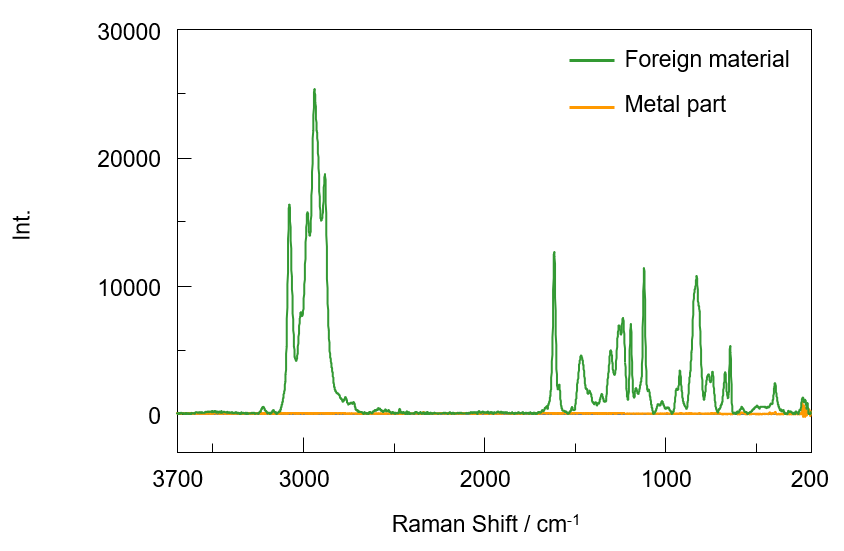Introduction
The first step in Raman microscopy is to determine the measurement point, and therefore it is important to perform visual observations of the sample being measured. The JASCO Raman microscope can be equipped with various observation functions, such as bright-field (epi-illumination), bright-field (transmitted illumination), dark-field, MIX, polarized, differential interference and dark-field fluorescence observation techniques, suitable for a wide range of samples. This report describes an original dark-field fluorescence observation technique developed by JASCO and its application to the analysis of foreign materials
Dark-field fluorescence observation (dark-field fluorescence mode)
Dark-field fluorescence mode is a unique observation technique available for use with JASCO Raman microscopes. The use of a dedicated objective lens and ring-shaped LED illuminator allows fluorescence emitted from a sample to be observed with a micro-Raman spectrometer. The illuminator has a compact size and there is no need to select a filter. Additionally, since the objective lens and illuminator can be easily mounted and dismounted using a slide-in mechanism, switching between observation modes is also effortless.
For dark-field fluorescence observations, two models are available: a 405 nm visible-light model (fluorescence wavelength: 480 nm or longer) and a 375 nm UV-light model (fluorescence wavelength: 420 nm or longer), which can be selected depending on the type of sample. Using dark-field fluorescence mode with a JASCO micro-Raman spectrometer, the sample measurement position can be easily set, which otherwise would not be possible without employing a separate fluorescence microscope.

Fig. 1 Comparison of observation techniques
Experimental
Sample
Foreign materials on metal part (optically transparent debris)
System
Instrument: NRS-5500 Raman spectrometer
Accessories: RMIX57 MIX observation unit, DFF-405 Dark-field fluorescence slider

Fig. 2 NRS-5500 Raman spectrometer
Parameters
Laser wavelength: 532 nm
Objective lens: Dark-field long W.D. (visible, 100x)
Exposure time: 15 sec
Accumulations: 2
Keywords
Fluorescence, foreign material, fiber, Raman spectroscopy, dark-field fluorescence observation
Results
Figure 3 shows the observation results for foreign material on a metal part using a 20x or 100x objective lens. No evidence of foreign material was found in bright-field (epi-illumination) mode, and only a low-contrast region could be seen even in dark-field mode. In contrast, foreign material could be clearly observed in dark-field fluorescence mode at 405 nm.

Fig. 3 Observation results
As shown in Figure 4, when the sample was measured using Raman spectroscopy, Raman signals were detected only from the foreign material. A database search for the Raman spectrum revealed that it is associated with epoxy resin, possibly from the adhesive used to bond metal parts.

Fig. 4 Raman spectra
Conclusion
The use of dark-field fluorescence mode allows visualization of sample regions that cannot be distinguished using other observation modes. This is expected to expand the range of samples that can be analyzed using a micro-Raman spectrometer. In addition to the example of residual adhesive described here, this mode has a wide range of applications including analysis of contamination such as oil stains, dust and fibers, accumulated layers of materials, and cross-sectional observations of fluorescent layers on films.






